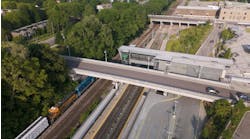L.A. Metro staff provides update on Eastside Gold Line
The Los Angeles County Metropolitan Transportation Authority (Metro) is providing updates on the Eastside Gold Line extension following the completion of technical studies.
One of the key projects with funding from L.A. Metro’s M ballot measure is an extension of the Eastside Gold Line from its current terminus at Atlantic Avenue in east L.A. Studies thus far have focused on two routes — one on Washington Boulevard to Whittier and the other to South El Monte along the 60 freeway with a third combined option that would also allow trains to run between South El Monte and Whittier.
With more information now in hand, L.A. Metro staff are recommending the following:
- Withdrawing the route along the 60 freeway to South El Monte and the combined (South El Monte-Whittier) routes from further consideration and focusing on building the Washington Boulevard alignment.
Technical studies found too many challenges with building a rail line along the 60, including steering tracks away from a Superfund site, not getting in the way of Caltrans planned widening of the 60, impacts to homes and environmentally sensitive areas and the lack of a large enough site for a rail yard.
- Metro is proposing to launch a feasibility study to look at other short- and long-term transit options outside this project that might better serve the needs of the area and the southern San Gabriel Valley.
- To expedite environmental studies going forward, staff is proposing to continue the state-required part of the studies (known as CEQA) and dropping the federally required part of the studies (known as NEPA). That would eliminate a federal review — which is time consuming — but also means that the project would not be eligible for federal funding at this time. L.A. Metro says it does not see that as problematic given that there are other projects that are more likely to be eligible for federal dollars anyway.
Measure M called for this project to be built in two phases with $6 billion in total funding. Under the Measure M spending plan, the first phase would begin construction in 2029 and be completed in 2035. The second phase would begin in 2053 and be done in 2057. The idea now is to focus on finishing the studies for the first phase on Washington and building that while using the separate feasibility study to determine what could be done now in the other corridor.
The Washington route includes a three-mile tunnel (mostly under Atlantic Boulevard), as well as a station near The Citadel shopping complex in Commerce. The route then follows busy Washington Boulevard with the train frequently traveling above the road on an aerial structure and or at-grade.
When L.A. Metro’s Regional Connector project is complete, trains from East Los Angeles will be able to travel directly to the heart of downtown Los Angeles and Santa Monica, meaning riders will no longer be required to transfer to the subway at Union Station. That will make for far faster rides for those on the Eastside Gold Line.
L.A. Metro staff are scheduled to take these recommendations to the L.A. Metro Board of Directors in February with the item first being heard in the board’s Planning and Programming Committee on Feb. 19 at Metro headquarters adjacent to Union Station in downtown Los Angeles. That meeting will be live-streamed.


